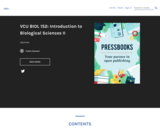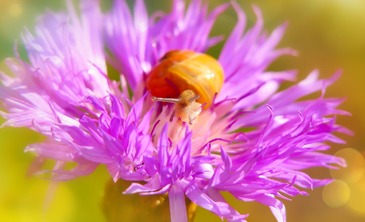
This textbook has been modified from OpenStax Biology by faculty at Virginia Commonwealth University. The goal was to provide students with a complete textbook with interactive features (reading quizzes, videos, links) that was highly engaging and, of course, at no cost to the students.
1. 1.1 Processes and Patterns of Evolution
2. 1.2 Evidence of Evolution
3. 1.3 Mutations
4. 2.1 Population Genetics
5. 2.2 Population Evolution
6. 2.3 Adaptive Evolution
7. 3.1 Speciation: Allopatric and Sympatric
8. 3.2 Speciation Isolation and Adaptation
9. 3.3 Reconnection and Speciation Rates
10. 4.1 Evolution and Classification
11. 4.2 Determining Phylogenetic Connections
12. 5.1 Prokaryotic Cell Structures
13. 5.2 Prokaryotic Growth & Metabolism
14. 5.3 Prokaryotic Diversity
15. 6.1 Evolution of Eukaryotic Cells
16. 6.2 Evolution of Simple Multicellularity
17. 6.3 Challenges to Complex Multicellularity
18. 7.1 Characteristics of Fungi
19. 7.2 Ecology of Fungi
20. 7.3 Classifications of Fungi
21. 7.4 Fungal Parasites and Pathogens
22. 7.5 Importance of Fungi in Human Life
23. 8.1 Land Plant Ancestors
24. 8.2 Adaptations of Plants to Land
25. 8.3 Seedless Non-Vascular Plants
26. 8.4 Seedless Vascular Plants
27. 8.4 Seedless Vascular Plants
28. 8.5 Seed Plants: Gymnosperms
29. 8.6 Seed Plants: Angiosperms
30. 9.1 Shoot Growth and Development
31. 9.2 Water Transport in Plants
32. 9.3 Sugar Transport in Plants
33. 10.1 Features of the Animal Kingdom
34. 10.2 Features Used to Classify Animals
35. 10.3 Early Animals
36. 10.4 Neurons and Glial Cells
37. 11.1 Types of Skeletons
38. 11.2 Muscles and Movement
39. 11.3 Protostomes
40. 11.4 Deuterostomes
41. 12.1 Evolution of Fishes
42. 12.2 Systems of Gas Exchange
43. 12.3 Evolution of Tetrapods
44. 12.4 Overview of the Circulatory System
45. 12.5 Fertilization in Animals
46. 12.6 Homeostasis in Animals
47. 13.1 Population Dynamics
48. 13.2 Population Growth
49. 13.3 Population Dynamics
50. 13.4 Interspecific Interactions
- Subject:
- Biology
- Life Science
- Material Type:
- Activity/Lab
- Assessment
- Homework/Assignment
- Textbook
- Author:
- Dianne Jennings
- Jonathan Moore
- Date Added:
- 11/05/2021
